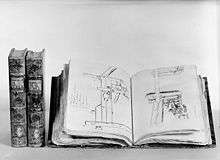Carl Johan Cronstedt
| Carl Johan Cronstedt | |
|---|---|
|
Eighteenth century sketch | |
| Born |
25 April 1709 Stockholm, Sweden |
| Died |
9 November 1779 Stockholm, Sweden |
| Occupation | Architect, inventor |
| Known for | Swedish architect |
| Spouse(s) | Countess Eva Margareta Lagerberg |
| Parent(s) | James Cronstedt (Olderman) / Margareta Beata Grundel |
Carl Johan Cronstedt (25 April 1709 – 9 November 1779) was a Swedish architect, inventor, count, noble, civil servant, scientist and bibliophile.[1][2]
Biography

Cronstedt was the son of Jakob Cronstedt (Olderman) and Margareta Beata Grundel. He was born in 1709 in Stockholm, Sweden.[2] He married Countess Eva Margareta Lagerberg in 1744.[2]
Cronstedt became a pupil of Christopher Polhem in 1729 and in 1733 was his apprentice.[2] He studied civil engineering under Carl Hårleman and in 1743 became his successor as superintendent.[2] He had this post to 1767 and carried out work at the following,
- Drottningholm Palace in the 1740s following Hårleman's architectial drawings.[2]
- Maria Magdalena Church restoration in Stockholm after the 1759 fire.[2]
- Construction of the new Amiralitetskyrkan in Karlskrona in 1760.[2]
- Involved in the construction of Drottningholmsteatern 1764 to 1765.[2]
- Did the drawings to Saint Olai Church in Liverpool which opened in 1767.[2]
Positions
- 1739 - Member of the Royal Swedish Academy of Sciences, which was founded the same year.[2]
- 1752 - Member of Swedish House of Lords.[2]
- 1767 - President in Kammarrevisionen.[2]
- 1769 - President in Kammarkollegium.[2]
Inventor

In the mid-eighteenth century Cronstedt, working together with Fabian Wrede, increased the efficiency of the wood-burning stove roughly eightfold with a new technology and invention.[1][4][5][6] Their 1767 redesign of the traditional wood-burning stove directed the smoke and heated gases through long flues that wound up and down inside the stove. The stove and its flues were built of special masonry bricks that captured, and then radiated, more heat from the burning process.[1][4][5][6] The new technology changed the pattern designs of large interior building space for residences and other public buildings.[1][4][5][6] It allowed more rooms to be heated with the same amount of firewood.[1][4][5][6] It had significant social and economical consequences throughout Sweden and later throughout Europe and America up into the twentieth century.[1][4][5][6] Cronstedt's invention had significant environmental significance as well because it saved forests from excess usage.[4]
Cronstedt showed how in a ceramic designed wood-burning stove that much more additional heat could be captured in a heavily tiled system of five long internal flues.[1][4] The innovation of his masonry stove system captured the heat from only periodic burning of wood. It would then spread out that heat over a longer period for a fairly constant temperature.[1][4] Because of this it only needed to be lit in the mornings and in the evenings.[1][4] This type of residential (or interior space) heating system is sometimes referred to as a kakelugn in a Swedish stove.[1][4] In England and America it is called a "tile stove" or masonry stove.[4] It is a type of "contra-flow stove" which the Chinese have made into a Kang bed-stove.[1]
Books written

Cronstedt wrote and had published several books. Among these were,
- 1767 - On a new installation of stoves for firewood saving.
References
- Carl Johan Cronstedts fullerösamling, Byggmästaren 1942, n. 9, p. 115-116
- Okänd fransk konstnär:Arkitekten Carl Johan Cronstedt, Nationalmusei årsbok 1946, n.s. v. 16, p. 112
- Carl Johan och F.A.U.:Cronstedts samlingar på det gamla Fullerö, Nationalmusei årsbok 1942/1943, n.s. v. 12, p. [39]-105
- Hofberg, Herman, Heurlin, Frithiof, Millqvist, Viktor, Rubenson, Olof, Svenskt biografiskt handlexikon, 1906 - a source now in public domain.
Notes
- 1 2 3 4 5 6 7 8 9 10 11 Quinn, p. 52
- 1 2 3 4 5 6 7 8 9 10 11 12 13 14 "Swedish Biography - Carl Johan Cronstedt". Retrieved 2008-07-17.
- ↑ "Kasko 1765 town plan design by superintendent Carl Johan Cronstedt". Retrieved 2008-07-17.
- 1 2 3 4 5 6 7 8 9 10 11 "Cronstedt in History - Scientific Inventions and Discoveries, Tiled Stoves ("Kakelugn")". Retrieved 2008-07-17.
- 1 2 3 4 5 "Energy Aspects in Swedish Building" (PDF). Archived from the original (PDF) on July 15, 2006. Retrieved 2008-07-17.
- 1 2 3 4 5 The Swedish Room By Lars Sjöberg, et al., ISBN 0-7112-0915-4, p. 67. Retrieved 2008-07-17.
Bibliography
- Quinn, Bradley et al., Scandinavian Style, Sterling Publishing Company, Inc. 2003, ISBN 1-84091-325-8
